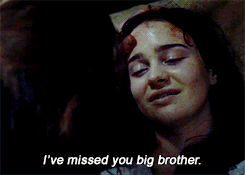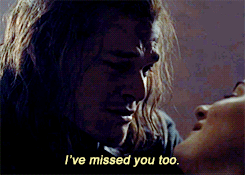Post by Deleted on Jun 6, 2016 14:56:42 GMT
Washington Post: Alyssa Rosenberg
A couple of weeks ago, the Atlantic ran a roundtable on the late, lamented Hodor (Kristian Nairn) and the way “Game of Thrones” has handled disability over the years. It’s a worthy theme, from the groundbreaking character work Peter Dinklage has done as Tyrion Lannister, to the way the series had handled the wound Jaime Lannister (Nikolaj Coster-Waldau) suffered at the hands of the Bloody Mummers and way Ramsay Bolton (Iwan Rheon) maimed Theon Greyjoy (Alfie Allen). And tonight’s episode of “Game of Thrones,” “The Broken Man,” looked squarely at people who have been physically and emotionally damaged by the war for the Iron Throne.
Sandor Clegane (Rory McCann) was one of the first symbols “Game of Thrones” gave us of the rot that was growing underneath Westeros’ chivalric ideals, his face scarred not in some honorable battle but by the cruelty and caprice of an older brother (Hafþór Júlíus Björnsson) who pushed him into the fire and held him there. As the Hound, he saw himself as damaged; by that fire, by the fear that lingered in him, and by the ugly things he did in service of a regime that was only too happy to put off its worst tasks on a man whose visage matched the part.
When service to that regime became untenable, Sandor behaved in ways that were consistent with his sense of himself. He was one of the first people to warn Sansa Stark (Sophie Turner) that her dreams about knights and kings were a lie; he stole Arya Stark (Maisie Williams) as a bargaining chip; and after failing to return Arya to her mother and gain a new master, we last saw him losing a bruising fight with Brienne of Tarth (Gwendoline Christie) and being left for dead by Arya. It’s not entirely clear whether Sandor means Brienne or Arya when he tells the septon it was a woman who did him in, but in either case, it’s a full reversal of roles. Knights are supposed to save damsels, not get their armor staves in by them.
...
Sandor Clegane (Rory McCann) was one of the first symbols “Game of Thrones” gave us of the rot that was growing underneath Westeros’ chivalric ideals, his face scarred not in some honorable battle but by the cruelty and caprice of an older brother (Hafþór Júlíus Björnsson) who pushed him into the fire and held him there. As the Hound, he saw himself as damaged; by that fire, by the fear that lingered in him, and by the ugly things he did in service of a regime that was only too happy to put off its worst tasks on a man whose visage matched the part.
When service to that regime became untenable, Sandor behaved in ways that were consistent with his sense of himself. He was one of the first people to warn Sansa Stark (Sophie Turner) that her dreams about knights and kings were a lie; he stole Arya Stark (Maisie Williams) as a bargaining chip; and after failing to return Arya to her mother and gain a new master, we last saw him losing a bruising fight with Brienne of Tarth (Gwendoline Christie) and being left for dead by Arya. It’s not entirely clear whether Sandor means Brienne or Arya when he tells the septon it was a woman who did him in, but in either case, it’s a full reversal of roles. Knights are supposed to save damsels, not get their armor staves in by them.
...











